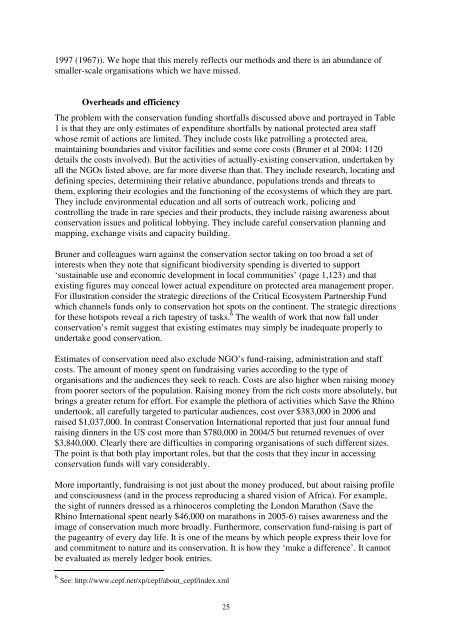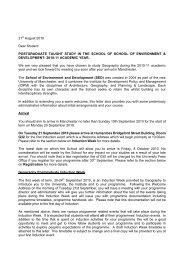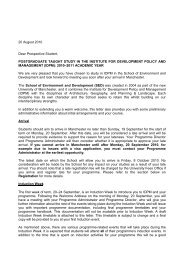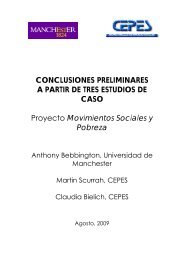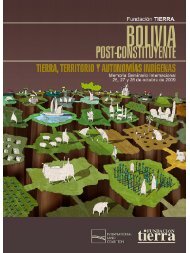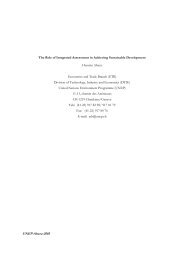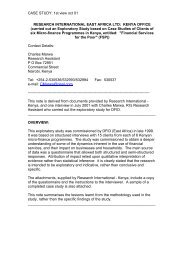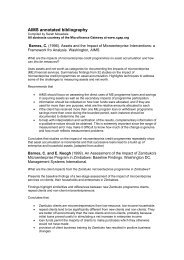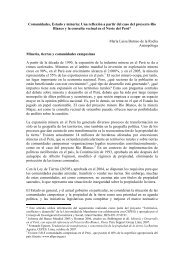Non Governmental Organisations and African Wildlife Conservation ...
Non Governmental Organisations and African Wildlife Conservation ...
Non Governmental Organisations and African Wildlife Conservation ...
You also want an ePaper? Increase the reach of your titles
YUMPU automatically turns print PDFs into web optimized ePapers that Google loves.
1997 (1967)). We hope that this merely reflects our methods <strong>and</strong> there is an abundance of<br />
smaller-scale organisations which we have missed.<br />
Overheads <strong>and</strong> efficiency<br />
The problem with the conservation funding shortfalls discussed above <strong>and</strong> portrayed in Table<br />
1 is that they are only estimates of expenditure shortfalls by national protected area staff<br />
whose remit of actions are limited. They include costs like patrolling a protected area,<br />
maintaining boundaries <strong>and</strong> visitor facilities <strong>and</strong> some core costs (Bruner et al 2004: 1120<br />
details the costs involved). But the activities of actually-existing conservation, undertaken by<br />
all the NGOs listed above, are far more diverse than that. They include research, locating <strong>and</strong><br />
defining species, determining their relative abundance, populations trends <strong>and</strong> threats to<br />
them, exploring their ecologies <strong>and</strong> the functioning of the ecosystems of which they are part.<br />
They include environmental education <strong>and</strong> all sorts of outreach work, policing <strong>and</strong><br />
controlling the trade in rare species <strong>and</strong> their products, they include raising awareness about<br />
conservation issues <strong>and</strong> political lobbying. They include careful conservation planning <strong>and</strong><br />
mapping, exchange visits <strong>and</strong> capacity building.<br />
Bruner <strong>and</strong> colleagues warn against the conservation sector taking on too broad a set of<br />
interests when they note that significant biodiversity spending is diverted to support<br />
‘sustainable use <strong>and</strong> economic development in local communities’ (page 1,123) <strong>and</strong> that<br />
existing figures may conceal lower actual expenditure on protected area management proper.<br />
For illustration consider the strategic directions of the Critical Ecosystem Partnership Fund<br />
which channels funds only to conservation hot spots on the continent. The strategic directions<br />
for these hotspots reveal a rich tapestry of tasks. 6 The wealth of work that now fall under<br />
conservation’s remit suggest that existing estimates may simply be inadequate properly to<br />
undertake good conservation.<br />
Estimates of conservation need also exclude NGO’s fund-raising, administration <strong>and</strong> staff<br />
costs. The amount of money spent on fundraising varies according to the type of<br />
organisations <strong>and</strong> the audiences they seek to reach. Costs are also higher when raising money<br />
from poorer sectors of the population. Raising money from the rich costs more absolutely, but<br />
brings a greater return for effort. For example the plethora of activities which Save the Rhino<br />
undertook, all carefully targeted to particular audiences, cost over $383,000 in 2006 <strong>and</strong><br />
raised $1,037,000. In contrast <strong>Conservation</strong> International reported that just four annual fund<br />
raising dinners in the US cost more than $780,000 in 2004/5 but returned revenues of over<br />
$3,840,000. Clearly there are difficulties in comparing organisations of such different sizes.<br />
The point is that both play important roles, but that the costs that they incur in accessing<br />
conservation funds will vary considerably.<br />
More importantly, fundraising is not just about the money produced, but about raising profile<br />
<strong>and</strong> consciousness (<strong>and</strong> in the process reproducing a shared vision of Africa). For example,<br />
the sight of runners dressed as a rhinoceros completing the London Marathon (Save the<br />
Rhino International spent nearly $46,000 on marathons in 2005-6) raises awareness <strong>and</strong> the<br />
image of conservation much more broadly. Furthermore, conservation fund-raising is part of<br />
the pageantry of every day life. It is one of the means by which people express their love for<br />
<strong>and</strong> commitment to nature <strong>and</strong> its conservation. It is how they ‘make a difference’. It cannot<br />
be evaluated as merely ledger book entries.<br />
6 See: http://www.cepf.net/xp/cepf/about_cepf/index.xml<br />
25


